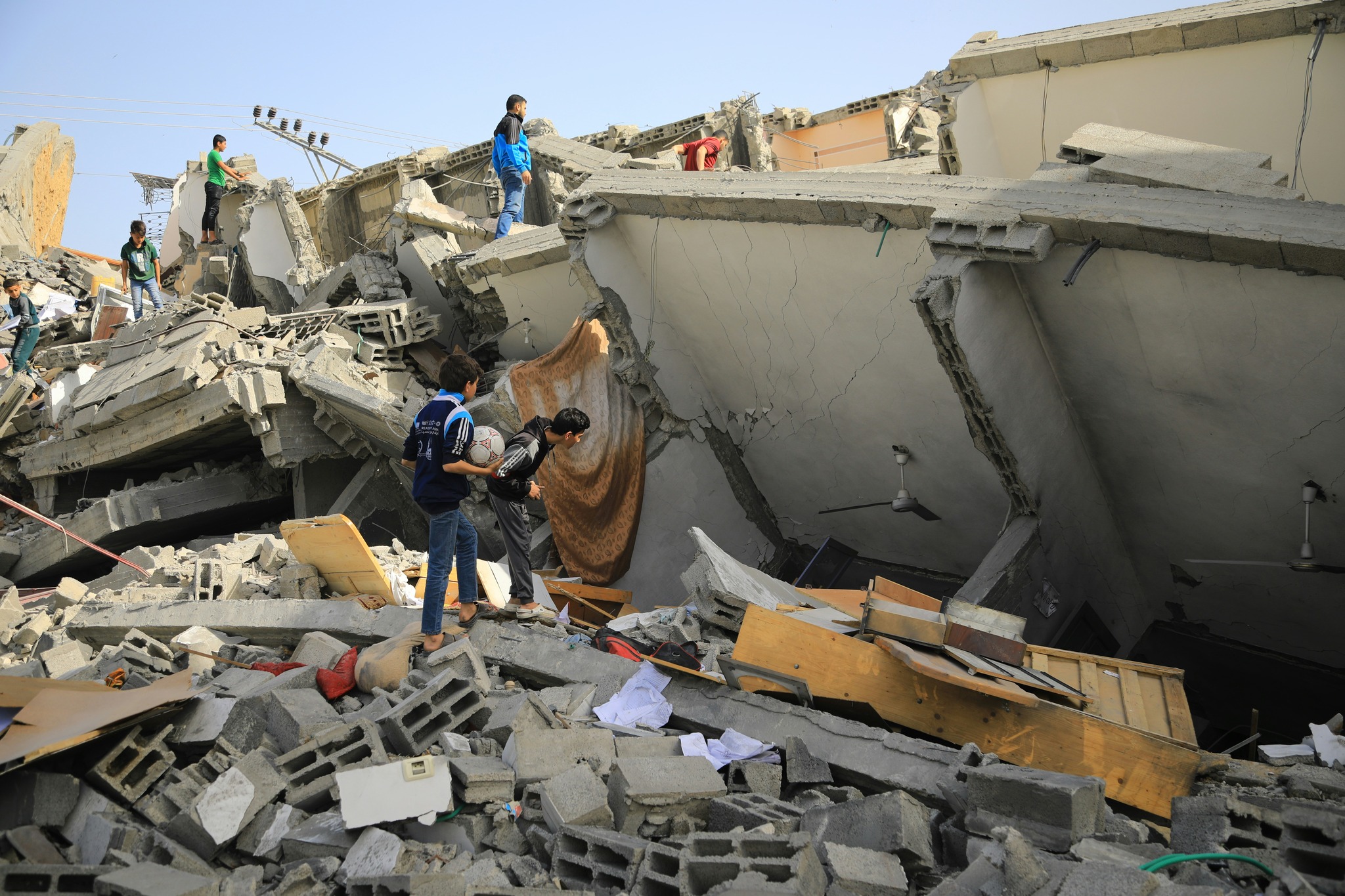This article first has been published in Persian by RadioZamaneh.
You can find the Greek version on TV Χωρίς Σύνορα.
Photo by Mohammed Al Bardawil on Unsplash
Gaza is breathing under a planned machinery of destruction: continuous bombing of residential areas, a total blockade, imposed famine, the dismantling of health care and water services, and organized obstruction of life-saving aid. These are not scattered wartime errors; they are a chain of decisions and directives targeting the Palestinian population, especially children. This article explicitly names the events in Gaza as “genocide”—not as political rhetoric, but grounded in recognized legal criteria and in evidence showing that civilians’ lives are being destroyed through intentional, systematic killing and deprivation.
This report focuses on children because they are at the forefront of this destruction: from direct deaths in attacks to severe malnutrition, preventable diseases, and the collapse of maternal and newborn care. We bring together what various sources—UN specialized bodies, research institutes, humanitarian organizations, and reputable media—have reported. We explain where the differences in figures come from and why “indirect deaths” (due to famine and deprivation) must be included in any realistic estimate. We then outline the legal and linguistic dimension: why using terms such as “massacre” and, especially, “genocide” for Gaza aligns with field evidence and established legal standards.
Your support helps keep this space alive but also ensures that these critical discussions remain accessible to all.
The Latest Picture of Casualties and Children’s Conditions
According to new reports from hospitals and health authorities in Gaza—echoed by international media—the total death toll has surpassed 64,800. The Gaza Ministry of Health says 420 malnutrition-related deaths have been recorded, including 145 children. The Associated Press, covering recent strikes on Gaza City, reported that at least 12 children were killed within a 24-hour period. These figures are hospital-based and, as explained below, do not necessarily capture all deaths.
UNICEF, the UN children’s fund, stressed in two recent statements that:
- More than 50,000 children have been “killed or injured” since the war began (27 May);
- With intensified operations in Gaza City, over 450,000 children are at immediate risk (12 September).
UNICEF also announced on 11 September that the rate of acute malnutrition among screened children across Gaza reached 13.5% in Mordad (August). In Gaza City—where the IPC (Integrated Food Security Phase Classification) has confirmed Famine (Phase 5)—the rate reached 19%, roughly one in five children. At the same time, the closure of about 10–12 outpatient malnutrition treatment centers due to escalating the war has disrupted care.
The IPC and the World Health Organization (WHO) stated on 22 August that famine in the Gaza Strip is confirmed and may spread to Deir al-Balah and Khan Younis. This is the first official famine declaration in the Middle East by this mechanism. The Israeli government called the announcement “confused” and challenged its methodology.
A Key Distinction: “Direct Deaths” vs. “Indirect Deaths”
Much of the statistical confusion comes from the difference between direct deaths (from injuries and explosions) and indirect deaths (from lack of medicine, safe water, food, maternal and newborn care, and preventable infectious diseases, etc.). In wartime, it is impossible to record every single death; so researchers use epidemiological modeling and “excess mortality” estimates—comparing deaths during the war with a hypothetical no-war scenario. This is where numbers can rise or fall and become contested.
Two key research pieces were published in the past year:
- A study by LSHTM (London School of Hygiene & Tropical Medicine; a university research institute in global health) combined several sources (mortuary records, a guided online survey, and obituary posts on social media) to estimate 64,260 deaths from injuries between 7 October 2023 and 30 June 2024. This was 41% higher than the Gaza Ministry of Health’s figures at that time, and the study stressed that non-injury deaths were not included in this count.
- An editorial letter in The Lancet (one of the most respected medical journals, published since 1823 and with one of the highest impact factors) reviewed other wars and proposed, as an initial estimate, a rough ratio of four indirect deaths for every direct death, warning that the real number in Gaza could be far beyond hospital-recorded figures. This estimate received both support and methodological criticism.
Where did the big numbers come from?
Based on those two pillars, two analytical pieces in Australian media—Arena Online (a research/analysis magazine) on 10 July 2025 and Independent Australia (an independent outlet) on 12 August 2025—tried to estimate the total deaths up to 25 April 2025. They extrapolated direct deaths to 136,000 and, by applying the 4-to-1 ratio, added 544,000 deprivation-related deaths; a total of 680,000. These notes also gave an age breakdown, including 380,000 deaths for children under five. These calculations have news value, but it should be stated clearly that LSHTM or The Lancet themselves did not publish such a “grand total” or an age breakdown. There are also critiques about how well the 4-to-1 ratio transfers to Gaza’s specific context. Still, these figures matter for showing what is actually happening on the ground.
Separately, Ralph Nader—a well-known Lebanese-American lawyer and activist—argued in an open letter 20 August, republished by Pearls and Irritations (an Australian public-policy analysis website), that media should include deprivation-related deaths in their counts, describing the real number as “likely above 500,000.” This is a methodological and moral call, not a registered statistic.
Methodology at a Glance
- Direct recording (administrative data): Hospitals, mortuaries, and relief teams log each death/injury case.
Advantage: Concrete and verifiable.
Limitation: In system collapse, the records are incomplete. - Expansion with statistical models: When records are incomplete, researchers like the LSHTM team use capture–recapture—overlapping several independent sources to estimate the “hidden total.”
Advantage: Better coverage.
Limitation: Depends on overlap assumptions and source quality. - “Excess deaths” and reference ratios: Where access is limited, the Lancet letter and similar studies use ratios observed in other wars (e.g., four indirect deaths for every direct death) for an initial estimate.
Advantage: Brings attention to “invisible” deaths.
Limitation: How well this ratio transfers to Gaza’s specific context is debated.
Children: From Bombardment to Famine
While registered figures show thousands of children killed by direct attacks, the other alarming trend is malnutrition and hunger. UNICEF reports that one-fifth of children in Gaza City suffered from acute malnutrition in August, and that the share of severe acute malnutrition—the deadliest form—among hospitalized children rose from 12% in February 2025 to 23% in August 2025. UNICEF adds that as attacks continue, nutrition treatment centers have been closed or relocated, disrupting children’s continuous care—an interruption that, amid famine, can be the difference between “recovery” and “death.”
The IPC and the World Health Organization stress that famine is human-made and preventable: through a ceasefire, safe and continuous humanitarian access, fuel for essential services (water, sanitation, health care), and a partial restoration of market functions. At the same time, the Israeli government has questioned the technical validity of the IPC report. For an Iranian reader, the practical meaning of famine is clear: preventable daily deaths, first among infants and very young children.
Prices and Purchasing Power: Translating into the Language of Livelihoods
To grasp the depth of the crisis for children, we must also look at families’ purchasing power. In spring and summer this year, UN agencies reported surging flour prices: in late May, one kilo of flour was reported at 60–100 shekels (about USD 16–27)—roughly 1.6–2.7 million tomans per kilo at fluctuating open-market rates. From mid-August to September, some official Israeli data and media reports noted a temporary dip due to limited inflows of goods. However, OCHA (the UN Office for the Coordination of Humanitarian Affairs) simultaneously reported high fuel prices and movement restrictions that undermine poor households’ access even to those limited goods. The outcome for children: fewer calories, near-zero dietary diversity, and a higher risk of malnutrition.
Legal and Linguistic Dimension: From “Massacre” to “Genocide”
In reporting on Gaza, several key terms are repeated, each with a different meaning and legal status. In Persian, “massacre” (or “mass killing”) is mostly descriptive and moral; but “genocide” is a precise legal concept under the 1948 UN Convention, and its use requires specific elements to be established. Understanding this distinction is essential for professional reporting—especially when the focus is on children. Under Article 2 of the Convention, genocide means committing any of the following acts—such as “killing members of the group,” “causing serious bodily or mental harm,” or “deliberately inflicting conditions of life calculated to bring about the group’s physical destruction in whole or in part”—against a national, ethnic, racial, or religious group, with the specific intent to destroy that group. This “specific intent” is the strict legal threshold that distinguishes genocide from other crimes.
In recent weeks, the International Association of Genocide Scholars (IAGS)—the largest academic body in the field with about 500 members—passed a three-page resolution which, according to the association’s president, was supported by 86% of voting members. The resolution states that “Israel’s policies and actions in Gaza meet the legal definition of genocide under Article 2” and calls for the immediate end to deliberate attacks on civilians, including children; starvation; denial of life-saving aid (water, fuel, medicine); sexual and reproductive violence; and forced displacement. IAGS president Melanie O’Brien (Professor of International Law at the University of Western Australia) told Reuters that the vote is “a clear statement by specialists in the field.”
Why does this matter for children? Parts of Article 2 directly overlap with children’s situation in Gaza: “killing members of the group” and “causing serious bodily or mental harm” apply to children’s direct casualties; and “inflicting conditions of life calculated to bring about destruction” is evidenced—especially in Gaza City—through the confirmed famine, acute malnutrition, and disrupted access to water, medicine, and maternal/newborn care documented by specialized agencies. For this reason, the IAGS resolution explicitly mentions children and identifies “starvation” and “denial of essential survival items” as prohibited acts.
Three core points are clear:
- Registered (hospital) figures show the minimum; reputable statistical research like LSHTM indicates even this minimum is likely undercounted.
- A large share of children’s loss of life occurs in indirect deaths—where famine, malnutrition, lack of clean water, preventable diseases, and the collapse of maternal and newborn services take effect.
- In legal and political discourse, terms such as “crime,” “genocide,” and “mass killing” are widely used by some independent bodies and experts; Israel rejects these characterizations, and the final judgment lies with international judicial institutions.
Despite disagreements over the “total number,” there is no dispute about children’s disproportionate share of suffering and death. All credible sources point to similar immediate remedies: a ceasefire; safe, sustained humanitarian access; fuel for essential services; and the minimal restoration of health and nutrition systems to prevent avoidable deaths—especially among children.
Method note: When you encounter differing figures in reports, check whether the number covers only direct deaths (hospital/forensic registrations) or also includes indirect deaths added through modeling. Understanding this difference—especially for children, who are most harmed by undernutrition, preventable disease, and the interruption of basic care—is key to grasping the true scale of the disaster.










Leave a Reply to Nad Cancel reply